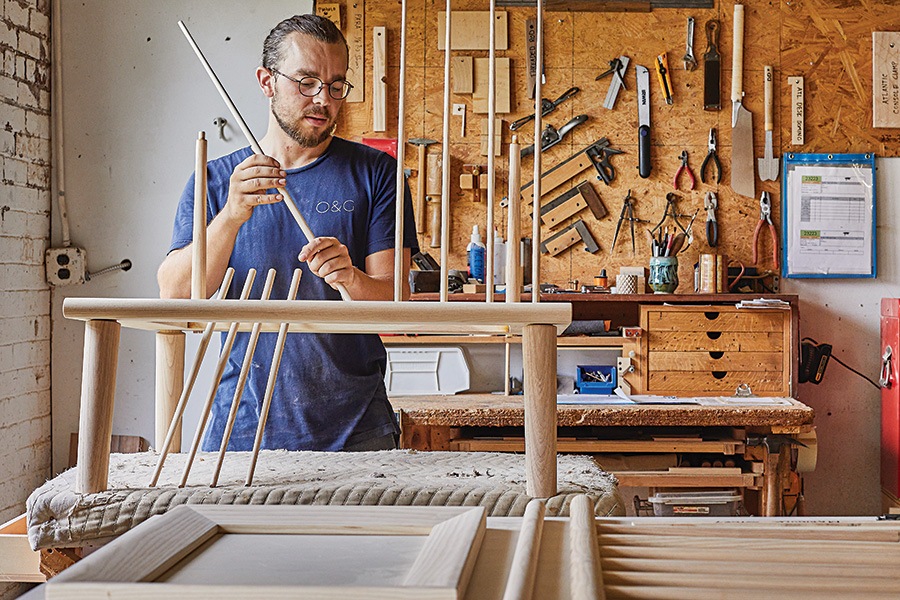Breaking With Tradition
O & G Studio modernizes New England historical craft to elevate the art form.

O & G Studio’s innovative interpretations of the classic Windsor chair put them on the industry’s radar—but that was just the beginning of its contributions to interior design. / Photo by Angel Tucker
It comes as no surprise that post-pandemic consumers continue to invest in heirloom-quality home furnishings. After spending so much time indoors, many people questioned how to enhance their surroundings. But long before COVID came along, O & G Studio created American furniture collections that provided an answer. Case in point is their handcrafted modernization of the iconic Windsor chair. With an extensive line of variations (the largest range in the country, in fact, from the line’s hide-back side to Touisset arm and everything in between), O & G’s Windsor has played a significant part in New England’s next generation of regional craftsmanship.

“About American furniture in particular, I think my initial experiences—especially in the high-end antique world—are a different type of visual training than art and design,” Jonathan Glatt says. “It all really came together and has informed how O & G designs have evolved.” / Photo by Angel Tucker
O & G, which was officially launched in 2009 by RISD alums Jonathan Glatt and Sara Ossana, started out as a two-person team. Today, the company has expanded to 27 employees with Glatt—a former jeweler, designer, and fabricator who also interned and worked at Sotheby’s Auction House in the American Furniture department—as sole proprietor. Originally working in a 200-square-foot studio within a historical mill in Warren, Rhode Island, O & G now occupies 20,000 square feet of space in that same location.
“We started with a Windsor chair, and as ubiquitous as it’s always been, at that moment it wasn’t cool,” Glatt says. “The Windsor was a great design object, but it was very hard to get people interested in it.” Because brown was the color du jour for contemporary and antique furniture during this time, O & G decided to do something different—by leaning into unique hues and focusing on the interior design trade as its customer. “One of our first colors was persimmon, which was picked up by the Wall Street Journal and went on to be Color of the Year that following year,” Glatt says. “We initially made four colors and then added a fifth (azimuth), which has become our most popular.”
Since then, O & G has expanded its color line to a wider range of options—from soft neutrals to bright, intense reds and blues. “Our color palette has become a signature of the company, created a broad audience for us, and made ways for people to plug into the line; and our coloring process is the only thing we consider a trade secret because it’s very hard to do.”

O & G furniture craftsman Jens Maynard-Dean works on a Matunuck Lounge Chair. As a business, Glatt says the umbrella of the process covers everything from the very abstract—what would this make somebody feel to look at and see—all the way down to the technical processes and how it’ll be manufactured. “And something I really love about the company is we’ve got an amazing team,” he adds. “Being able to grow the business and design more has created a lot of opportunity for everyone to develop individually and as a group. We’re way beyond the size where this is an individual endeavor.” / Photo by Angel Tucker
While the firm’s variations on the Windsor chair put O & G on the industry’s radar, the team has also expanded its offerings while employing new techniques in fabrication and material work along the way. “The idea has been taking what was that initial design approach to the Windsor chair, zooming out, and pulling in my other interests and knowledge into a whole home line of products ranging from upholstery to case goods,” Glatt notes. “What makes our designs different is that they have a lot of layers of detail. They’re designed to be compelling from far away, but the details get finer and finer as you get closer.”
As for O & G’s design process, Glatt notes there’s no specific blueprint. “Some pieces start on paper, some pieces start directly in the shop with just rough prototypes,” he reveals. “We work first on scale, proportion, and comfort. Then several passes are done to refine all of the shapes and details that will bring a piece together.” At the same time, the team is engineering and considering the manufacturing. Additionally, O & G typically makes pieces around a theme so that each item isn’t its own little island. “You keep that through line through everything,” Glatt says, “but each piece is a little different.” As an example, he references one of their most recent collections, Intervalo, which features the Doca lounge chair, Campina coffee table, Lula ottoman, and Torre floor lamp (among other pieces) and celebrates relaxed luxury and the inviting comfort of New England summers.
Capturing that feeling for customers both inside and outside of the region is something special. “It’s exciting when someone from somewhere completely different finds a place where our collections work,” Glatt says. “In some ways, we are hyper-regional, but the ideas are designed to appeal beyond where we are to provide people with an experience.”
First published in the print edition of Boston Home’s Winter 2024 issue, with the headline, “Breaking With Tradition.”


